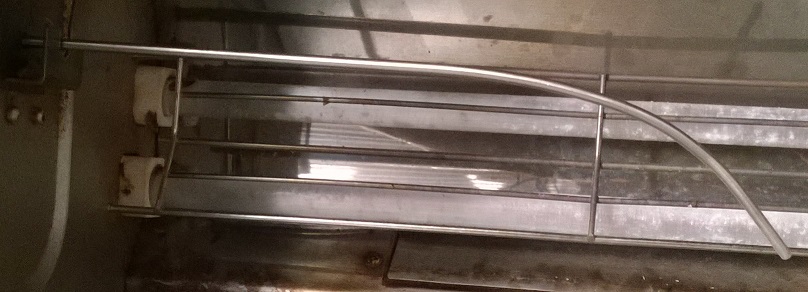Well, my extremely hacked Behmor finally lives. Full computer control and an actual working bean temperature probe. I'll be documenting it more as time goes on, but for the moment here's three not very good pictures of the bean temperature probe.
The solid state relays that control the heater, afterburner and cooling fan. Kind of over sized for the last two, but it's what I had on hand.I have it hooked up so one relay controls both the afterburner and the scroll fan. I thought of separating them as turning off the afterburner and leaving the fan on might help cooling. The relays mount to those two aluminum strips which are mounted to the panel that the original control board was mounted to. You can also see I took out the fan that sucked air from that area and set it out the exhaust. I blocked off the hole with a piece of thin metal. I assume the fan on the newer side panel will move enough air to keep the temperature cool enough.
The socket for the bean probe. Again, quite a bit of overkill, but that's the chunk of aluminum that was laying around.
The socket as seen through the the hole in the left side panel.
The probe fully inserted into the socket.

What the probe looks like placed into the chamber. No drum, as I can't seem to get the camera to see into the drum. It does work, though.
The plug that makes sure the bean probe is always correctly aligned when inserted.
Side view of the plug. The side is flat because when I inserted the stop pin in the probe socket it pushed into the nice round hole and made it not round. The flat on the other side was for a set screw that ended up not being used since the probe stays in place through a roast with no help at all. I might press a magnet into the socket someday as a retention device.
The plug on the side of the roaster that the control box connects to. It's not the connector I would have chosen given a choice, but it was the only panel mount 6-pin connector I could find in my office.
The 6-pin plug from the backside of the panel. You can see there are only five wires, one is 12V to power everything, three of the other four connect to the negative terminals of the SSRs and turn them on when connected to ground. If it seems counterintuitive, I understand, but from the side where you're designing circuits, it's much easier to switch ground then it is to switch 12V. The last wire supplies 12V to the drum motor and fan. I will add the sixth wire and separate those two at some point as which will allow me to control the drum speed. Right now it runs at high speed all the time.
The hole in the axle as see from outside the drum.
The hole in the axle as seen from inside the drum. Notice I made the hole on this side bigger so the bent part of the probe would not get stuck during insertion and removal.
The container from BB&B I put the controls in to keep them protected and visible.
The control board container with the lid off so you can see everything inside. The skinny white relay almost touching the three pin terminal block controls the power to the drum motor and the fan mounted on the side panel. The three blue two-position terminal blocks control the three solid state relays. The heater is PWM at about 30hz, which means I can set the power anywhere I want between 0 and 100%. There are two thermocouple sockets. I had the second one in the exhaust channel which seems mostly useless, but I can't think of anywhere useful to put it so it stays there for now.
The control box plugged into the roaster. You can also see the 14ga power cord with ground I replaced the original one with. I wanted bigger wire but mostly I wanted a ground given what I was doing.
Here are 4 graphs from the first few roasts. Red is bean temp and blue is exhaust. I was having trouble with the bean temp probe moving as I've not properly restrained it yet so the graphs aren't perfect, but they sure show promise.
I just uploaded my current database to the Sharing page which has logs of all the roasts done on FrankenBehmor.
I don't have a picture of it handy but there is a reasonably well equipped one of these at my disposal which makes stuff like this possible. http://www.smithy.com/graniteCLASSIC
And there is one of these at the house in case I can't get to the shop to use the big one: http://www.use-enco.com/CGI/INSRIT?PMAKA=110-0800&PMPXNO=1617068&PARTPG…
